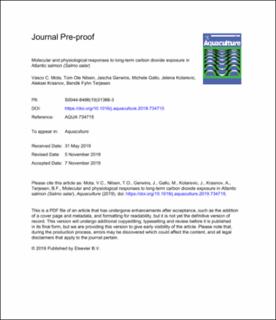| dc.description.abstract | Optimal water quality is vital for the growth of Atlantic salmon aquaculture production. Recent data showed that Atlantic salmon feed intake and growth reduce linearly with increasing water carbon dioxide (CO2) concentrations, suggesting that even relatively low concentrations may impact fish performance. This study evaluated the molecular and physiological responses of Atlantic salmon (Salmo salar) to long-term CO2 exposure. For this purpose, Atlantic salmon post-smolts (N = 900; 67 ± 8 g) were exposed to six CO2 treatments (5, 12, 19, 26, 33 and 40 mg/L) for 12-weeks (RAS phase) followed by non-CO2 exposure for a (<5 mg/L) period of 6-weeks (seawaterphase). Results from blood analysis of fish exposed to CO2 for 12 weeks showed that CO2 lead to significantly higher pH, K+, HCO3− and PCO2 and lower Na+ and Cl− plasma concentrations. Whereas, haematocrit, Ca+, Mg2+, urea and glucose concentrations were similar among all CO2 treatments. After 6 weeks in the seawater phase, all the parameters that were previously altered, became similar among all CO2 treatments. Gill microarray results analysis showed 88 differentially expressed genes, resulting from the CO2 exposure. At the end of the RAS phase (week 12), fish exposed to high CO2 (40 mg/L) in comparison to fish exposed to low CO2 (5 mg/L), showed 60 down-regulated genes, including genes encoding proteins involved in immune responses, differentiation, and maintenance of tissue structure. There was no evidence for stress and metabolic changes directed to neutralization of disturbance caused with high CO2. After 6 weeks in the seawater phase, a switch of expression from down regulated to up-regulated was observed. In conclusion, the present study brings new insights on the molecular and physiological responses of Atlantic salmon post-smolts to long-term CO2 exposure. Several osmoregulation and acid-base balance parameters as well as gill gene expression levels were altered for as long as CO2 exposure persisted. Moreover, most of these parameters were linearly related with the environmental CO2 concentrations (5–40 mg/L range). The data from this study adds to recent findings that CO2 concentrations below the 15 mg/L threshold still have an impact on Atlantic salmon. This finding may be relevant for a better dimensioning and management of production systems where CO2 may accumulate in the water such as in recirculating aquaculture systems (RAS). | |

